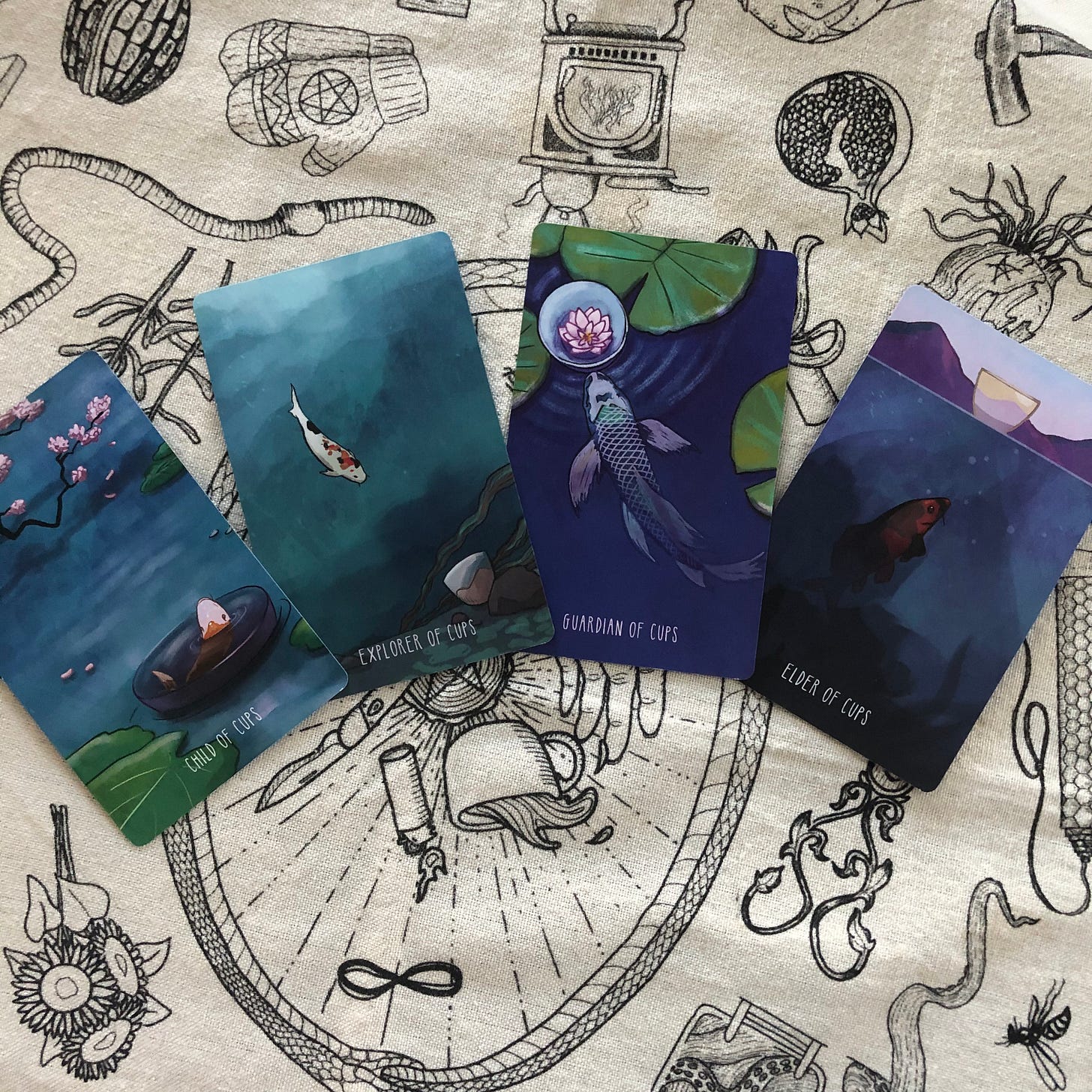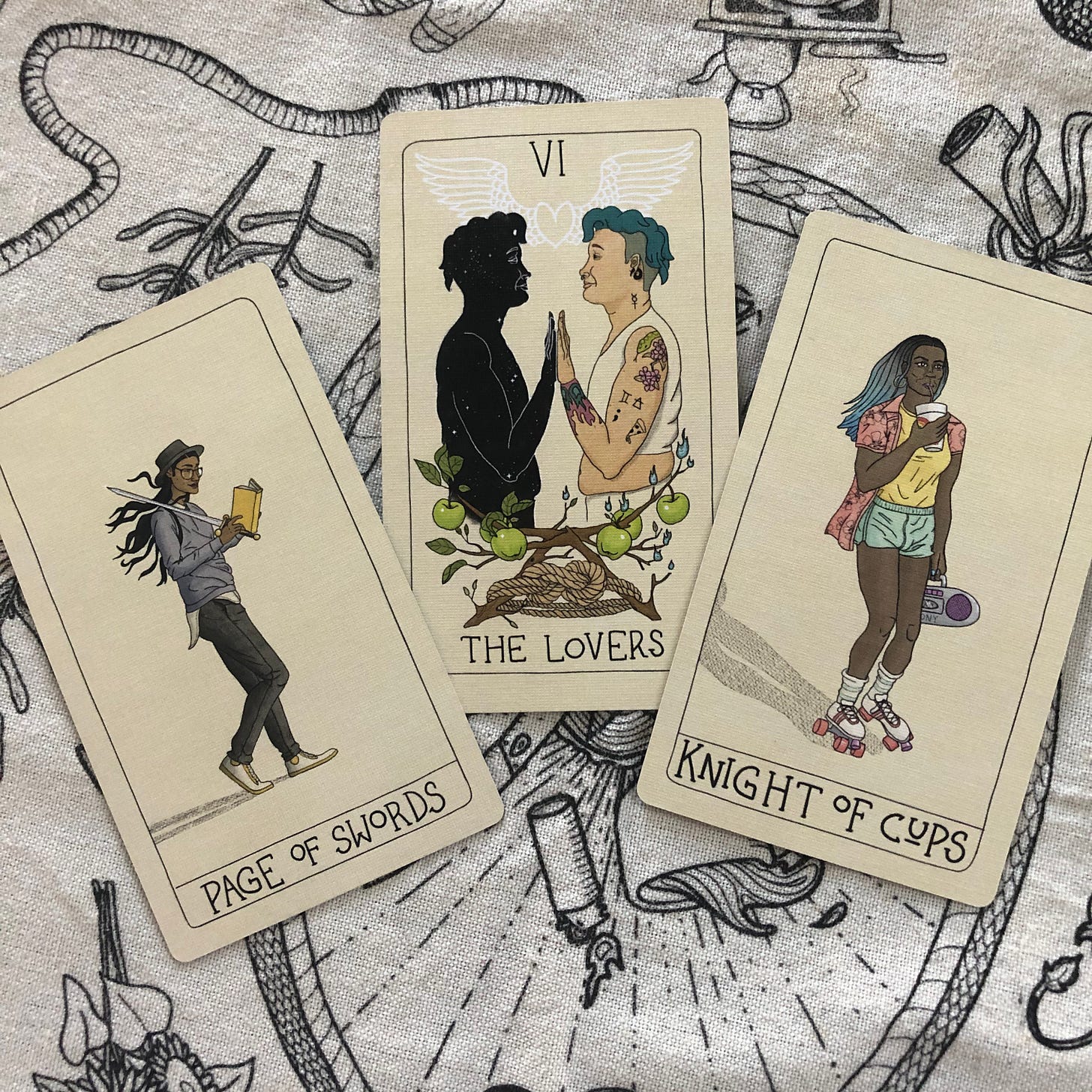In the year before my transition, I read my own Tarot every day. I spent that year in free-fall; deciding to transition seemingly required dealing with every other trauma in my life first, as if my gender were hidden in one of a hundred identical storage boxes in a basement and I had to go through them all, one-by-one, to find what I was looking for. I wasn’t sure what gender I was, which meant I wasn’t sure who I was, and it was very possible that I would turn out to be someone that my husband didn’t want to be married to, or that my mother didn’t want to parent, or that my daughter found too embarrassing to love.
So I read Tarot, every day at lunch time, because, when you’re in the middle of an identity crisis that may end in the loss of your entire family, it’s comforting to feel that you know some part of the future. I didn’t feel comfortable talking to anyone about what was happening to me, but the cards became a regular, friendly presence in my life, reflecting my own circumstances and thoughts back to me, the way a good friend will often just rephrase your own thoughts in a way that allows you to hear them.
Then my Tarot cards started stressing me out, and I was screwed. The problem with Tarot is that its archetypes are traditionally sorted into gender binaries — The Magician and the High Priestess, the Empress and the Emperor, etc. — and older decks often have a pretty strict idea of which bodies can occupy which roles. You’re supposed to read Tarot in a relaxed, meditative state, and it was impossible to do that when the cards kept pointing toward the least relaxing part of my life. It’s also traditional to choose a significator from among the court cards to represent yourself; I’m an air sign over 30, so I was supposed to choose either the Queen of Swords or the King of Swords, and there were days when that decision alone was too much.
Thus, my quest to find the One True Transgender Tarot Deck began, because when you’re dealing with one large, overwhelming problem, it can help to divert some of your energy into a smaller, more manageable obsession, like buying too many Tarot decks online. These are the best I found over the course of my search. They undeniably reflect my personal tastes and needs — a deck that feels perfect to a binary trans woman might not work for me, and vice versa — and this is not a remotely complete list. Still, in the desperate hope that this search is relevant to anyone but me, I’m sharing my recommendations with you now.
The Spacious Tarot, $54
One really simple approach to taking gender out of the cards is to take people out. In my bad year, I used a lot of decks based around animals and nature imagery, like the Wild Unknown Tarot, which I’ve had since the queer Internet discovered Tarot in 2014, and one of my favorite decks, the Wooden Tarot, which I got as a gift. A dear friend uses the Brady Tarot, which comes with a guidebook by Original Trans Tarot Person Rachel Pollack.

However, even these decks contained gendered court cards -- King, Queen, Knight, Page — which, at the time, were the bane of my existence. “Progressive” decks softened those archetypes down to Mother and Father, which did exactly nothing to solve the problem. At least traditional decks have the Page, who is specifically an androgynous person. In the Wild Unknown, you have to be “the Daughter.” What the fuck is that?
Thus, I landed on the Spacious Tarot. It’s unassumingly beautiful — nature scenes drawn in a clean, almost comic-book style — and people always ask the name of the deck when I post photos of it, which suggests it might be the biggest crowd-pleaser.

The Spacious Tarot bypasses the tyranny of court cards; instead of the Page, Knight, King and Queen, you now get to decide whether you are a Child, an Explorer, a Guardian or an Elder. (I’m an explorer, which is unfortunate, because the Explorer of Swords is traditionally a bit of a dick.) All of the Major Arcana keep their traditional names, but it’s easier to understand the difference between Empress and Emperor when you stop imagining it as “mommy vs. daddy” (whose mommy? whose daddy?) and envision it, as this deck does, as the difference between a field of wildflowers and a strictly cultivated garden.
Also, not to jump to conclusions, but the card backs and box are clearly designed in the trans flag colors, which suggests that someone knew exactly which absurdly specific personal crisis they were designing for. Top marks for effort.
The Next World Tarot (Pocket Edition), $20
I saw this deck at bookstores (remember bookstores?) for months when it first came out, but I didn’t think it was for me. For one thing, the cards looked huge — great for display, useless for shuffling, especially if you are a small person with embarrassing tiny hands — and it cost nearly $50. For another, I was in an awkward, eggy stage wherein I felt insecure around Radical Queer Art. I wanted to connect, but instead of looking for the points of commonality, I’d inspect the art for signs that it did not consider me worthy of inclusion.
Yes: I was afraid to buy a Tarot deck because I thought it wouldn’t like me. I’m very tough. But at least one of my trans friends uses it, so it came recommended, and when I saw the publisher had made a miniature (read: usable) deck for $20, I picked it up.

I have this deck set aside to use on bad days now. I find it immensely soothing. It has a clear political viewpoint — the Justice card is a protest, the Tower is replaced with “Revolution,” etc. — and yes, the aesthetic is very Cool Queer. But there are just so many kinds of people here: Not just trans or gender non-conforming people, but people who are fat, disabled, older, non-white. They’re not just in The One Card Included So You Know The Artist Is Cool, they’re everywhere. The Court cards use traditional titles, but the figures on them can be any gender, as can the figures anywhere else. The diversity of the deck makes it hard to feel left out, and it’s very calming to see all these bodies presented without controversy, as just how people are.
The deck is also intentionally easy to read, with little keywords and astrological associations printed out in the margins, so if you’re looking for a good first deck, or a gift, this — especially at the price — makes it hard to fuck up.
My lord, this deck is wholesome. It just feels gentle — the homespun, kind of Moosewood Cookbook line drawings, the toned-down color scheme, the simple domestic imagery. The King of Cups is quite clearly a portrait of Mr. Rogers. It’s printed on good card stock, that thick, linen-textured stuff that makes just touching the deck a little bit of an experience. These are all immensely likable features, but they’re not my favorite thing. This is: It’s drawn by a non-binary artist, Charlie Claire Burgess, and in the guidebook, every human figure in the deck is a “they.”

You could read the bodies in this deck any number of ways. Some of them have beards and top surgery scars. Some have breasts and long hair. Some wear binders. Some are overtly not-cis — the begowned Empress with chest hair, the bearded Emperor with breasts — and some, you’d likely sort into “man” or “woman” at first glance. All of this belongs in the non-binary tarot deck, all of it counts; it’s a big umbrella, and there’s really no way to do it wrong.
There’s no way to do it wrong. No matter how many tests you assign to yourself, no matter how long you deliberate, the only way to know you’re trans is to know it. Sooner or later, you realize that whether or not you need to transition, you are someone who has needed to ask his Tarot cards the same question about transitioning, every day at lunch, for a year. No matter how you do your gender, no-one can tell you whether you’ve gotten it right. No matter what you look like, you are what your gender looks like. There is no test to pass. There is no standard to meet. There are no authorities you can go to for validation or rejection, because the only authority on your gender is you.
It’s a little bit silly, needing to have your gender affirmed by your Tarot cards. As I’ve come out, I’ve needed it less and less. I’m affirmed by my clothes and my hair and my friends and my family and my marriage; needing it from a pack of cards feels like overkill. Still: I remember how raw and lost I was, in the year before my transition, and how important it was to have any kind of anchor. I remember the sense of inauthenticity and craziness and worthlessness that dogged me — that still dogs me, on bad days — and how anxious I was to know whether there was anyone like me, or anywhere I belonged.
I don’t believe in fortune-telling. I think the cards are a mirror, a way for you to get in touch with your own gut instinct. Tarot cards were a way to imagine myself forward in time; to envision the choices I might make and the person I was capable of becoming. I was looking for my future, and I wanted to see a future that had me in it. It matters more than you’d think. We’re all pulling the future toward us, creating new pictures of what’s coming, one draw at a time.
—
More horror next week! I’ve been writing about a lot of real-world horrors, though, if you care to read: First, how Marilyn Manson told us he was an abuser, and second, on Britney Spears, a woman who has been trying to obtain basic bodily autonomy for decades, and getting denied every time.